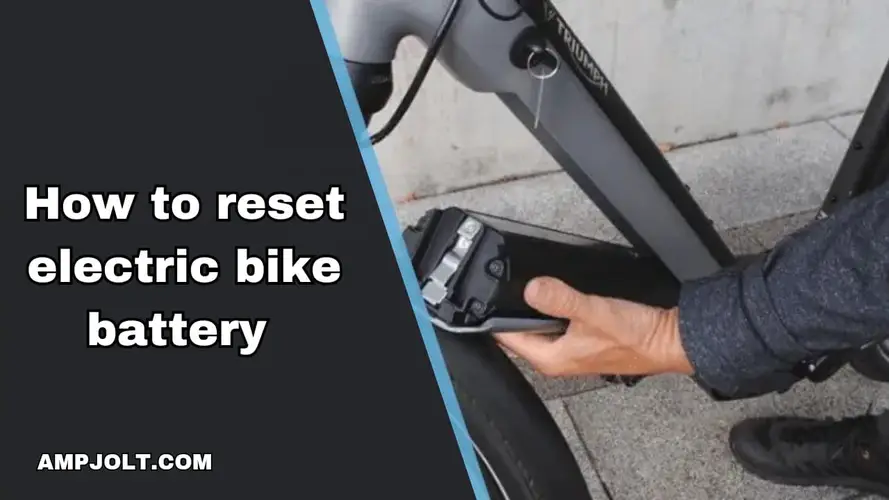How to open hood of car with dead battery?
April 14, 2018

As electric bikes revolutionize how we commute and explore, understanding how to reset their batteries becomes essential for maintaining peak performance. Over time, an electric bike's battery may experience fluctuations in performance or display inaccurate readings.
To reset your electric bike battery, ensure it's fully charged, power off the bike, and locate the reset button on the battery or control unit. Press the reset button for 10-15 seconds, then release. Power on the bike, observe indicator lights, and test ride to confirm improved battery performance.
This comprehensive guide delves into the step-by-step process of resetting your electric bike battery, ensuring it operates efficiently and provides a reliable ride every time.
Before jumping into the reset process, it's crucial to understand the basics of electric bike batteries. Most e-bikes use lithium-ion batteries due to their high energy density, lightweight design, and longevity. These batteries, however, can experience issues like capacity loss, voltage imbalances, or inaccurate readings, leading to a need for resetting.
If you notice a significant decrease in your electric bike's range over time, it may indicate capacity loss. Resetting the battery management system (BMS) can recalibrate the capacity readings and restore accurate range estimations.
Voltage imbalances among the cells within the battery can occur, affecting overall performance. Resetting the battery system helps balance voltage levels, ensuring consistent power delivery and preventing premature wear.
Occasionally, the battery's state of charge display might become inaccurate. A reset can recalibrate the system, providing more precise readings and improving the overall reliability of the battery indicator.
Begin by consulting your electric bike's user manual. Manufacturers often include specific instructions for resetting the battery based on the bike's model and type.
Ensure the battery is fully charged before initiating the reset process. Connect it to the charger and wait until the battery reaches its maximum charge level.
Power off the electric bike and disconnect it from the charger. Allow the cycle to sit for a few minutes to ensure it is entirely powered down.
Some electric bikes have a designated reset button on the battery or the bike's control unit. Consult your user manual to identify the location of the reset button.
Press and hold the reset button for a specified duration, typically 10-15 seconds. The reset process is initiated during this time, and the battery management system is recalibrated.
After holding the reset button for the required duration, release it. The electric bike's battery system should now be reset, and you may observe a series of indicator lights or displays confirming the reset.
Power on the electric bike and check the battery indicator or display for accurate readings. The reset process should improve the reliability of the battery's state of charge display and overall performance.
Take your electric bike for a short test ride to ensure the reset has positively impacted its performance. Monitor the battery's behavior and range during the ride.
In some cases, a single reset may not fully address the issues. If you continue to experience problems, consult your user manual for additional guidance on troubleshooting or consider seeking professional assistance.
Implement regular maintenance routines for your electric bike, including checking and tightening connections, keeping the battery clean, and following the manufacturer's recommendations.
Avoid fully depleting your battery regularly. Lithium-ion batteries tend to perform better when kept within a specific charge range. Aim to keep your battery level between 20% and 80% for optimal longevity.
Store your electric bike in a cool, dry place, especially during periods of non-use. Extreme temperatures can affect battery performance, so avoiding exposure to heat is crucial.
Adhere to the manufacturer's guidelines for charging cycles, storage, and usage. Each electric bike model may have specific recommendations to ensure optimal battery health.
Resetting your electric bike battery is a valuable skill to enhance its overall performance and longevity. Understanding the nuances of lithium-ion batteries and following a systematic reset process allows you to maintain accurate readings, balance voltage levels, and enjoy a reliable and efficient ride every time you hop on your electric bike. Regular maintenance and preventive measures further contribute to the longevity of your electric bike's battery, ensuring many miles of eco-friendly and enjoyable journeys ahead.
Resetting the battery helps address issues like capacity loss, voltage imbalances, and inaccurate readings, enhancing overall performance and reliability.
Resetting is typically done when you notice significant capacity loss, voltage imbalances, or inaccurate readings. It's not a routine procedure and should be done as needed.
While possible, it's highly recommended to consult the user manual, as specific instructions may vary based on the bike's model and battery type.
Yes, starting the reset process with a fully charged battery is essential to ensure accurate recalibration of the battery management system (BMS).
Refer to your user manual to locate the reset button. It is often on the battery or the bike's control unit. The manual provides specific details for your bike model.
A short test ride is recommended to ensure the reset positively impacts the battery's performance. Monitor the battery's behavior and range during the ride.
If problems persist, consult your user manual for additional troubleshooting guidance. In some cases, seeking professional assistance may be necessary.
Yes, regular maintenance, avoiding deep discharges, storing the bike in a cool place, and following manufacturer guidelines contribute to optimal battery health, reducing the need for frequent resets.
You can reset the battery on your own by following the user manual. If issues persist or you are uncertain, professional assistance may be advisable for a thorough inspection.
The reset process typically takes around 10-15 seconds, but the overall time may vary based on your familiarity with the process and the specific requirements of your electric bike model.
Comments
Write a comment